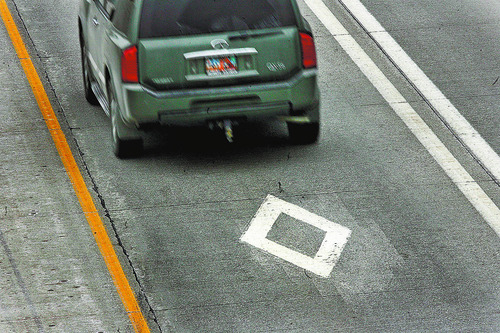This is an archived article that was published on sltrib.com in 2014, and information in the article may be outdated. It is provided only for personal research purposes and may not be reprinted.
Rick Votaw figured that his sleek, new $140,000 electric Tesla car not only would reduce air pollution, but would qualify him to buy a Utah clean-fuel vehicle decal to use freeway express lanes without paying tolls or carpooling.
"But they said, 'We can't give you one. The lanes are oversubscribed,'" Votaw fumes.
Last year, the Legislature passed HB23 to limit the number of clean-fuel vehicle passes — called C Decals — to 6,000 to prevent express lanes from becoming too crowded. The state has now hit that cap, said Linda Hull, director of policy and legislative services for the Utah Department of Transportation.
But Votaw protests that the state still allows cars carrying just a driver to pay tolls to use express lanes, even though that program loses money every year.
"How does allowing people access by charging tolls reduce pollution?" he asks. "We are schizophrenic in this state," saying lawmakers aim to reduce air pollution, but won't issue more C Decals while still taking money from toll payers in carpool lanes.
Votaw, a former vice chairman of the Salt Lake County Republican Party, this week took his concerns to the Legislature's Transportation Interim Committee, although lawmakers only listened without comment.
UDOT says it already has been conducting a study of issues related to express-lane access.
"A comprehensive study of the HOV [high-occupancy vehicle] lane is currently underway, including an examination of travel speeds, vehicle occupancy rates, how toll rates affect use by Express Pass holders, and use by C Decal holders," Hull said.
Interstate 15 express lanes were built, Hull said, to encourage "people to carpool and take more cars off the road by reducing the number of solo drivers, which reduces traffic congestion."
But since carpools didn't fill the lanes initially, the state decided to issue C Decals (which have a one-time cost of $10) and to create a toll program.
Because express lanes were built with federal money, federal rules require average speeds there to remain above 45 mph to attract carpools. If speed falls below that, Hull said the state could be forced to either increase required occupancy for carpools, or remove all solo driver cars, including C Decal users and toll payers.
Hull said with the growing popularity of hybrid and natural-gas cars, UDOT noticed it had been issuing more than 100 C Decals a month in recent years.
It worried about clogging express lanes, so it pushed for legislation to put a cap on them.
While the cap was set at 6,000, it allows UDOT to issue more if studies show it wouldn't hurt express-lane operations. Hull said the current study is looking at how many more might be allowed. Meanwhile, new C Decals are issued only when one is retired as a car is sold or junked — awarded by lottery among applicants.
Hull said the reason C Decals were capped but the toll program continues is that electronic signs can raise and lower tolls according to congestion to use "market forces … to push Express Pass holders out of the lane leaving more capacity for carpoolers." It cannot similarly vary C Decal use.
Votaw complains that the $1 maximum toll now charged is not a true disincentive, and the toll program doesn't raise enough money to pay for itself.
"A dollar isn't a deterrent, it really isn't. If I had my choice and it was crowded, it could be $2 or $3 and I'd still pay it," Votaw said.
Hull said the current study is looking at how much tolls deter use, and how high they should be.
The toll by transponder program has never paid for itself, but UDOT has tried to close the funding gap.
For fiscal 2014 (ending June 30), UDOT figures tolls will cover 93 percent of the cost — falling $53,000 short of the $761,000 expense.
"We will continue to work toward making the program self-supporting," Hull said.
Some 15,893 vehicles have toll transponders, according to UDOT. More than 6,800 of those were not used during the month of May. Another nearly 6,000 were used 10 times or less.
Hull said with the Wasatch Front's population expected to double by 2050 "the HOV lane will be a key tool to provide drivers with reliable travel times."
Votaw still thinks express lanes should be used more to reward clean-fuel cars than toll payers. "We are disincentivizing those who have spent a lot of extra money buying electric cars or high, high mileage cars. That's irritating."







